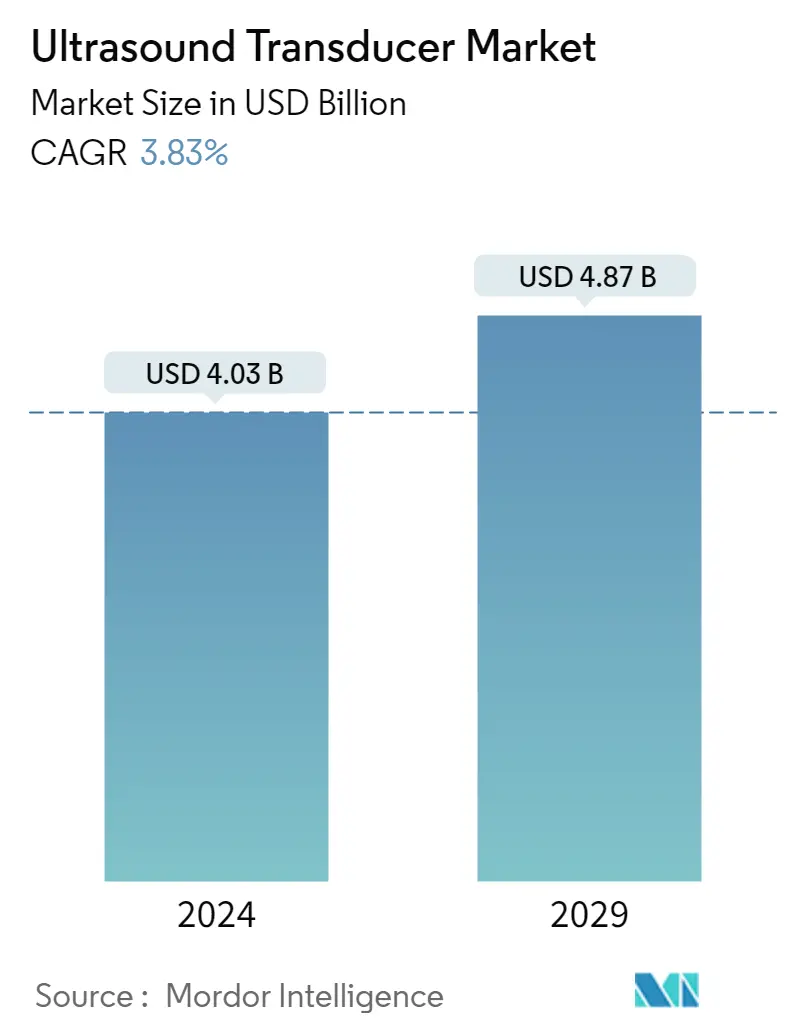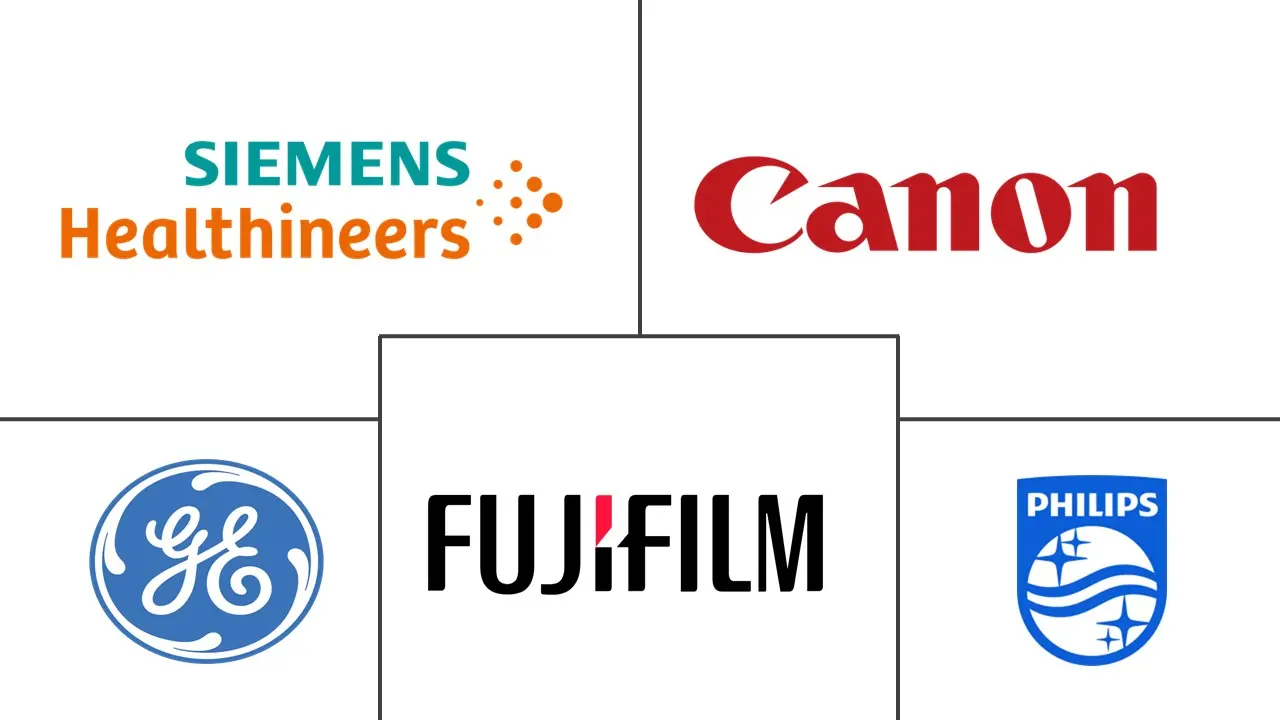Market Size of Ultrasound Transducer Industry

| Study Period | 2021 - 2029 |
| Market Size (2024) | USD 4.03 Billion |
| Market Size (2029) | USD 4.87 Billion |
| CAGR (2024 - 2029) | 3.83 % |
| Fastest Growing Market | Asia-Pacific |
| Largest Market | North America |
Major Players
*Disclaimer: Major Players sorted in no particular order |
Ultrasound Transducer Market Analysis
The Ultrasound Transducer Market size is estimated at USD 4.03 billion in 2024, and is expected to reach USD 4.87 billion by 2029, growing at a CAGR of 3.83% during the forecast period (2024-2029).
The COVID-19 pandemic has significantly impacted the ultrasound transducer market. According to an October 2021 published article in Current Opinion in Anaesthesiologist, ultrasound machines, transducers, and coupling gels can serve as vectors for the transmission of pathogens. Ultrasound is a front-line diagnostic and monitoring tool for patients with COVID-19. In COVID-19 patients, ultrasound can be used for transthoracic echocardiography, and ultrasound-guided thoracentesis and vascular access. For instance, according to the study published in Frontiers in Big Data, in March 2021, growing evidence around the world is showing that lung ultrasound examination can detect manifestations of COVID-19 infection. Such studies have driven market growth during the pandemic. Moreover, standardized strategies were recommended to minimize the risk of the spread of COVID-19 to patients and healthcare providers, which is in turn expected to boost the market's growth to pre-pandemic levels.
The major factors contributing to the market's growth are the rising demand for minimally invasive therapies and the increasing prevalence of cardiovascular, respiratory, and abdominal disorders. According to a research study by Karoline Freeman et al., published in BMC Gastroenterology Journal March 2021, globally, the incidence of inflammatory bowel disease (IBD) was found to be 69.5 per 100,000 population. In addition, according to the study published in BMC Medicine in February 2022, meal-related stomach pain is common all over the world, and it's linked to other Gastrointerstinal(GI) and non-GI physical symptoms, psychological distress, healthcare use, and a lower quality of life. People who have frequent meal-related stomach pain are more likely to meet the diagnostic criteria for disorders of gut-brain interaction (DGBI). Such rise in abdominal conditions will lead to adoption of ultrasound for the diagnosis of abdominal conditions, driving the market growth due to higher adoption of ultrasound transducers.
Moreover, the rising demand for minimally invasive therapies is another major factor driving the market growth. According to the study published in IEEE Transactions on Medical Imaging in April 2021, ultrasound imaging is predicted to take the role of X-ray fluoroscopy as the gold standard in minimally invasive spinal surgery. Researchers are working to develop ultrasonic imaging for navigation, taking advantage of its unique characteristics of being user-friendly and radiation-free. Such applications ultrasounds in minimally invasive surgeries replacing the harmful X-ray fluoroscopy will therefore lead to higher adoption driving the market growth.
Minimally invasive approaches, including ultrasound-guided techniques, are being used significantly. Thus, several market players are launching products, boosting the ultrasound transducer market's growth. For instance, in December 2021, Philips introduced cardiac ultrasound solutions for a fully integrated echocardiography experience, bringing together new transducer technology, artificial intelligence (AI)-driven automated measurements, and remote access at EuroEcho 2021. Additionally, in March 2021, Fujifilm SonositePX launched a new family of transducers, including the L19-5, Sonosite'shighest frequency transducer ever, with well-defined near field resolution and a scan depth of 1 cm. The L19-5 transducer has a tiny footprint of 20 mm, making it appropriate for superficial scans including vascular access, pediatrics, and musculoskeletal assessments. Such launches will also boost the market growth due to the availability of the products in the market, therefore, lead to rise in adoption. Such factors altogether are anticipated to drive the market's growth over the forecast period.
However, the market's growth is hampered by stringent regulations and a scarcity of skilled labor to operate the advanced equipment.
Ultrasound Transducer Industry Segmentation
As per the scope of the report, an ultrasound transducer is a probe that produces sound waves and makes echoes. The device is used in surgical, diagnostic, and non-invasive procedures. The market is segmented by product (Convex, Linear, Endocavitary, Phased array, CW Doppler), by application (Musculoskeletal, Cardiovascular, Obstetrics and Gynecology, General Imaging, and Others), by the end user (Hospitals, Diagnostic Centers, Ambulatory Surgical Centers, and Others) and geography (North America, Europe, Asia Pacific, Middle-East and Africa, and South America). The report also covers the estimated market sizes and trends for 17 countries across major regions globally. The report offers the value (in USD million) for the above segments.
| By Product | |
| Convex | |
| Linear | |
| Endocavitary | |
| Phased array | |
| CW Doppler | |
| Others |
| By Application | |
| Musculoskeletal | |
| Cardiovascular | |
| OB/GYN | |
| General Imaging | |
| Others |
| By End User | |
| Hospitals | |
| Diagnostic Centers | |
| Ambulatory Surgical Centers | |
| Others |
| Geography | ||||||||
| ||||||||
| ||||||||
| ||||||||
| ||||||||
|
Ultrasound Transducer Market Size Summary
The ultrasound transducer market is poised for steady growth over the forecast period, driven by increasing demand for minimally invasive therapies and the rising prevalence of cardiovascular, respiratory, and abdominal disorders. The market's expansion is further supported by the growing adoption of ultrasound in diagnosing and monitoring conditions, including those related to COVID-19. The pandemic highlighted the utility of ultrasound as a diagnostic tool, which has contributed to its increased adoption. Additionally, advancements in ultrasound technology, such as the development of AI-driven solutions and radiation-free imaging, are enhancing its application in minimally invasive surgeries, thereby boosting market growth. The introduction of innovative products by key players, such as Philips and Fujifilm, is also expected to drive market adoption and expansion.
North America is anticipated to hold a significant share of the global ultrasound transducer market, attributed to the high prevalence of chronic diseases and the demand for advanced medical devices. The United States, in particular, is a major contributor to this growth, with strategic initiatives by companies like Butterfly Network and Mindray enhancing market penetration. The market is moderately competitive, with major players including Koninklijke Philips N.V., Siemens Healthineers, and GE Healthcare, among others, actively engaging in product launches and strategic partnerships to strengthen their market position. Despite challenges such as stringent regulations and a shortage of skilled labor, the market is expected to witness significant growth, driven by technological advancements and increasing healthcare needs.
Ultrasound Transducer Market Size - Table of Contents
-
1. MARKET DYNAMICS
-
1.1 Market Overview
-
1.2 Market Drivers
-
1.2.1 Rising Demand of Minimally Invasive Therapies
-
1.2.2 Increasing Prevalence of Cardiovascular, Respiratory, and Abdominal Disorders
-
-
1.3 Market Restraints
-
1.3.1 High Cost of the Ultrasound Product
-
-
1.4 Porter's Five Forces Analysis
-
1.4.1 Threat of New Entrants
-
1.4.2 Bargaining Power of Buyers/Consumers
-
1.4.3 Bargaining Power of Suppliers
-
1.4.4 Threat of Substitute Products
-
1.4.5 Intensity of Competitive Rivalry
-
-
-
2. MARKET SEGMENTATION (Market Size by Value - USD million)
-
2.1 By Product
-
2.1.1 Convex
-
2.1.2 Linear
-
2.1.3 Endocavitary
-
2.1.4 Phased array
-
2.1.5 CW Doppler
-
2.1.6 Others
-
-
2.2 By Application
-
2.2.1 Musculoskeletal
-
2.2.2 Cardiovascular
-
2.2.3 OB/GYN
-
2.2.4 General Imaging
-
2.2.5 Others
-
-
2.3 By End User
-
2.3.1 Hospitals
-
2.3.2 Diagnostic Centers
-
2.3.3 Ambulatory Surgical Centers
-
2.3.4 Others
-
-
2.4 Geography
-
2.4.1 North America
-
2.4.1.1 United States
-
2.4.1.2 Canada
-
2.4.1.3 Mexico
-
-
2.4.2 Europe
-
2.4.2.1 Germany
-
2.4.2.2 United Kingdom
-
2.4.2.3 France
-
2.4.2.4 Italy
-
2.4.2.5 Spain
-
2.4.2.6 Rest of Europe
-
-
2.4.3 Asia-Pacific
-
2.4.3.1 China
-
2.4.3.2 Japan
-
2.4.3.3 India
-
2.4.3.4 Australia
-
2.4.3.5 South Korea
-
2.4.3.6 Rest of Asia-Pacific
-
-
2.4.4 Middle East and Africa
-
2.4.4.1 GCC
-
2.4.4.2 South Africa
-
2.4.4.3 Rest of Middle East and Africa
-
-
2.4.5 South America
-
2.4.5.1 Brazil
-
2.4.5.2 Argentina
-
2.4.5.3 Rest of South America
-
-
-
Ultrasound Transducer Market Size FAQs
How big is the Ultrasound Transducer Market?
The Ultrasound Transducer Market size is expected to reach USD 4.03 billion in 2024 and grow at a CAGR of 3.83% to reach USD 4.87 billion by 2029.
What is the current Ultrasound Transducer Market size?
In 2024, the Ultrasound Transducer Market size is expected to reach USD 4.03 billion.

